DNA
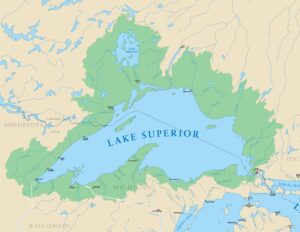
 I was born on the tip of Lake Superior, in a little town called…you guessed it, Superior in Wisconsin. While my family moved to Casper, Wyoming when I was three years old, we have been back to Superior many times, and I still consider Superior, Wisconsin my hometown. It’s like the lake and that whole area is a part of my DNA. I love our visits back there, and so many of my cousins still live there, so there will always be ties to the area. I’ve read books about the many ships that have been victim to the storms and the rocky shores in some areas, and I love to look at pictures that some awesome people post on Facebook. I know about the name that was given by the Native Americans…Gitche Gumee, which means “Big Sea” or “Huge Water” just about always refers to Lake Superior. I know about the November Gales that hit Lake Superior every November, that can easily take down an unsuspecting ship that ventured out too late in the year.
I was born on the tip of Lake Superior, in a little town called…you guessed it, Superior in Wisconsin. While my family moved to Casper, Wyoming when I was three years old, we have been back to Superior many times, and I still consider Superior, Wisconsin my hometown. It’s like the lake and that whole area is a part of my DNA. I love our visits back there, and so many of my cousins still live there, so there will always be ties to the area. I’ve read books about the many ships that have been victim to the storms and the rocky shores in some areas, and I love to look at pictures that some awesome people post on Facebook. I know about the name that was given by the Native Americans…Gitche Gumee, which means “Big Sea” or “Huge Water” just about always refers to Lake Superior. I know about the November Gales that hit Lake Superior every November, that can easily take down an unsuspecting ship that ventured out too late in the year.
Some say Lake Superior is the largest of the Great Lakes. Some say it is actually an inland sea. It is the world’s largest freshwater lake. In fact, Lake Superior is in a class by itself…and that makes it a national treasure. Its character is very unique. It looks and feels like an ocean. If you have ever seen it, your first thought is that you can’t see to the other side…like an ocean. The Lake accommodates the big ships…big ore ships, big grain haulers, the really huge ships. When you watch them come into the port, you find yourself amazed that you could be standing there beside them. Their very entrance into the port is a daily tourist attraction…and the locals love it too. Some people say that “A day on Lake Superior leaves you exhilarated, connected, restored. The Lake’s energy courses through your bones right to your soul. What a gift.” Yes, Lake Superior is most definitely a gift to be sure.
Some scientists say that Lake Superior is truly an inland sea…even if it is fresh water and not salt water. The maritime agencies take weather, navigation and buoyage very seriously, and they monitor them carefully. People are not encouraged to venture out on Lake Superior until they have met the bottom-line amount of knowledge necessary to initiate a healthy relationship with the lake. That bottom-line amount of knowledge includes paying attention to equipment, your level of training, and definitely the surrounding environment. 
 These are all important things that are recommended before a person ventures out onto any ocean or sea, which sort of classifies Lake Superior as an inland sea too. I suppose each person will have their own opinion on this, but since I have spent some time there, I tend to think that while it will always be Lake Superior to me, it will also be what I must agree, an inland sea.
These are all important things that are recommended before a person ventures out onto any ocean or sea, which sort of classifies Lake Superior as an inland sea too. I suppose each person will have their own opinion on this, but since I have spent some time there, I tend to think that while it will always be Lake Superior to me, it will also be what I must agree, an inland sea.

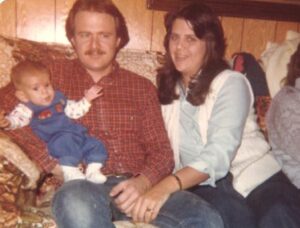 No one wants to think about an innocent person going to prison for a crime they did not commit, and I like to think that it doesn’t happen very often, but I think there was a time when it was a little more common that it is these days. While it may not happen as often these days as it used to, more and more of these wrongful incarcerations are coming to light these days, because of DNA testing. Michael Morton (born August 12, 1954) was convicted in a Williamson County, Texas court in 1986, of murdering his wife, Christine Morton. He never gave up the fight. He maintained in innocence until the end, and in the end, it was proven that he was in fact, innocent. Unfortunately, that did not mean that he was spared a prison sentence. He actually spent almost 25 years behind bars, sadly.
No one wants to think about an innocent person going to prison for a crime they did not commit, and I like to think that it doesn’t happen very often, but I think there was a time when it was a little more common that it is these days. While it may not happen as often these days as it used to, more and more of these wrongful incarcerations are coming to light these days, because of DNA testing. Michael Morton (born August 12, 1954) was convicted in a Williamson County, Texas court in 1986, of murdering his wife, Christine Morton. He never gave up the fight. He maintained in innocence until the end, and in the end, it was proven that he was in fact, innocent. Unfortunately, that did not mean that he was spared a prison sentence. He actually spent almost 25 years behind bars, sadly.
On the afternoon of August 13, 1986, a neighbor found 31-year-old Christine Morton beaten to death in her bed in the Williamson County, Texas, home near Austin, that she shared with Michael, a grocery store manager, and their 3-year-old son, Eric. The investigation began, and six weeks later, Morton, who had no criminal record or history of violence, was arrested for Christine’s murder. At trial, the prosecution contended Morton had slain his wife of seven years after she refused to have sex with him on the night of August 12, his 32nd birthday. Morton stated repeatedly that he had nothing to do with his wife’s death and said an intruder must have killed her after he left for work early on the morning of August 13. No witnesses or physical evidence linked Morton to the crime. There wasn’t anything circumstantial or ever really anything alleged to connect him to the crime, except that he had access to the home. Nevertheless, Michael Morton was convicted on February 17, 1987, and sentenced to life behind bars. So began his nightmare.
During his trial and subsequent time in prison, Morton’s defense team asked the state to test DNA on a variety of items, including a blood-stained bandanna found by police the day after the murder at an abandoned construction site close to the Morton home. For whatever reason, the Williamson County district attorney successfully blocked all requests for testing until 2010, when a Texas appeals court ordered that testing on the bandana take place. The team’s persistence finally paid off. The test results revealed the bandana contained Christine Morton’s blood and hair, along with the DNA of another man, Mark Alan Norwood, who was a felon with a long criminal record. Norwood had worked in the Austin area as a carpet layer at the time of the murder.
Finally, after waiting almost 25 years for real justice, Michael Morton was released on October 4, 2011. A month after Morton was freed, Norwood, who was by then 57, was arrested for Christine Morton’s killing. In March 2013, he was found guilty of her murder and sentenced to life in prison. Based on DNA evidence, Norwood also was indicted for killing a second woman, Debra Baker, whose 1988 murder in Austin had remained unsolved. Like Morton, Baker was bludgeoned to death in her bed. She lived just blocks from Norwood at the time of her murder. Michael Morton was officially exonerated in December of that year.
After a yearlong investigation into prosecutor, Ken Anderson, the State Bar of Texas filed a disciplinary petition against Ken Anderson in October 2012. By then, the prosecutor was a Texas district, elected in 2002. The Texas State Bar alleged that Anderson had withheld various pieces of evidence from Morton’s attorneys, including a transcript of an August 1986 taped interview between the case’s lead investigator and Morton’s mother-in-law, in which she stated that Morton’s then 3-year-old son, Eric had told her in detail about witnessing his mother’s murder and said his father was not home at the time. Anderson managed to pull off a plea deal to settle the charges against him. He agreed to serve 10 days in jail, perform 500 hours of community service, give up his law license and pay a $500 fine. I think that is an outrageous miscarriage of justice. He had knowingly withheld evidence that cost another man 25 years of his life. He should have had to serve the same length of time.
Morton was later able to re-establish contact with his son, who had cut ties with him when he was fifteen, because he then believed that he had not remembered the incident correctly, and it was his dad who had killed 
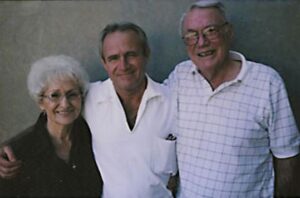 his mom. A further miscarriage of justice that was handed down to the elder Morton. He had not only lost 25 years of his own life, but an additional 13 years of his son’s life. Thankfully, Christine Morton’s sister adopted Eric Morton, so his dad was able to find his son when he got out of prison. When his was released, Morton lived with his parents in Liberty City, Texas for a while, before moving to Kilgore, Texas. In 2013, Morton married Cynthia May Chessman, who he met at his church.
his mom. A further miscarriage of justice that was handed down to the elder Morton. He had not only lost 25 years of his own life, but an additional 13 years of his son’s life. Thankfully, Christine Morton’s sister adopted Eric Morton, so his dad was able to find his son when he got out of prison. When his was released, Morton lived with his parents in Liberty City, Texas for a while, before moving to Kilgore, Texas. In 2013, Morton married Cynthia May Chessman, who he met at his church.
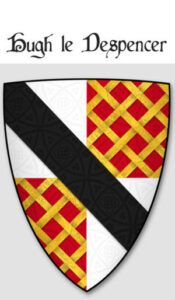 For many years, I thought my Spencer line came from England, but some things didn’t quite add up. When I started seeing DeSpencer and Le DeSpencer, I suspected that we might have immigrated to England from France, which my DNA proved to be correct. I’m more French than English. Nevertheless, for centuries, my Spencer ancestors did live in England, married English people, and so the line blended into more English blood in the current Spencers.
For many years, I thought my Spencer line came from England, but some things didn’t quite add up. When I started seeing DeSpencer and Le DeSpencer, I suspected that we might have immigrated to England from France, which my DNA proved to be correct. I’m more French than English. Nevertheless, for centuries, my Spencer ancestors did live in England, married English people, and so the line blended into more English blood in the current Spencers.
One Hugh le DeSpencer, who was the 1st Baron le DeSpencer, whose connection to me, while most assuredly there, would have to be researched to determine the level of cousinship, or whatever other relationship it is; was an important ally of Simon de Montfort during the reign of Henry III. He served briefly as Justiciar of England in 1260. In the “Middle Ages in England and Scotland the Chief Justiciar was roughly equivalent to a modern Prime Minister of the United Kingdom as the monarch’s chief minister.” Baron le DeSpencer also served as Constable of the Tower of London. “The Constable of the Tower is the most senior appointment at the Tower of London. In the  Middle Ages a constable was the person in charge of a castle when the owner…the king or a nobleman…was not in residence. The Constable of the Tower had a unique importance as the person in charge of the principal fortress defending the capital city of England.”
Middle Ages a constable was the person in charge of a castle when the owner…the king or a nobleman…was not in residence. The Constable of the Tower had a unique importance as the person in charge of the principal fortress defending the capital city of England.”
As chief justiciar of England, Hugh Le DeSpencer, first played an important part in 1258, when he was prominent on the baronial side in the Mad Parliament of Oxford, so called because they apparently argued a lot… and because of a possible misspelling of the word insigne as insane in whatever this says…”Hoc anno fuit illud insane parliamentum apud Oxoniam.” In 1260 the barons chose Le DeSpencer to succeed Hugh Bigod as Justiciar, and in 1263 the king was further compelled to put the Tower of London in his hands. He was the son 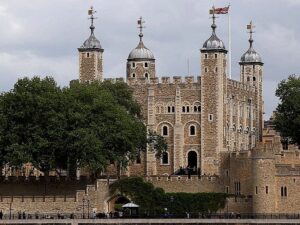 of Hugh le DeSpencer I, born in about 1223 and was summoned to Parliament by Simon de Montfort. Hugh was summoned as Lord DeSpencer on December 14, 1264 and was Chief Justiciar of England and a leader of the baronial party, and so might be deemed a baron, although that may not have been completely legal.
of Hugh le DeSpencer I, born in about 1223 and was summoned to Parliament by Simon de Montfort. Hugh was summoned as Lord DeSpencer on December 14, 1264 and was Chief Justiciar of England and a leader of the baronial party, and so might be deemed a baron, although that may not have been completely legal.
He remained allied with Montfort to the end, and was present at the Battle of Lewes. He was killed fighting on de Montfort’s side at the Battle of Evesham in August 4, 1265. He was slain by Roger Mortimer, 1st Baron Wigmore. That killing caused a feud to begin between the DeSpencer and the Mortimer families.

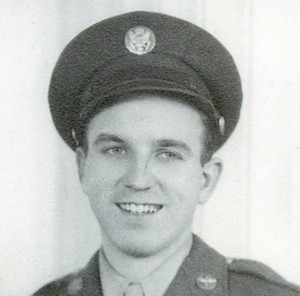 While listening to an audible book about World War II, called “Flak,” I heard one of the men being interviewed by the author for the book say, “History is told by the survivors.” It occurred to me that in most cases, at least in eras gone by, that was the truth. In order to know what really happened, there had to be a survivor. Even today, in an era of DNA, forensic science, black boxes, and phone video, there are events that cannot be definitively explained, and causes that remain a mystery.
While listening to an audible book about World War II, called “Flak,” I heard one of the men being interviewed by the author for the book say, “History is told by the survivors.” It occurred to me that in most cases, at least in eras gone by, that was the truth. In order to know what really happened, there had to be a survivor. Even today, in an era of DNA, forensic science, black boxes, and phone video, there are events that cannot be definitively explained, and causes that remain a mystery.
In World War II, survival was one of the main necessities to properly make an account of events. One might be able to look at pictures an know that the attack was bad, but in order to understand what it meant to fly through flak, someone had to really explain what the flak looked like up close, and tell us how hot it was when it got close enough to put a hole in the fuselage of the plane. We can imagine the fear the soldiers of World War II felt, but only because someone has “painted” a picture of just how bad it was to be pinned down in a foxhole with bombs raining down all around you, and bullets flying past if you tried to get out and run. No amount of 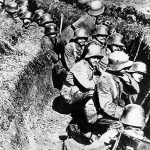 modern technology can explain how a soldier might have felt upon looking at his helmet to find a hole in it where shrapnel pierced it, and the soldier received only a small scratch. All of the “facts” that can be gleaned from the modern technology we have simply can’t tell us about how people felt.
modern technology can explain how a soldier might have felt upon looking at his helmet to find a hole in it where shrapnel pierced it, and the soldier received only a small scratch. All of the “facts” that can be gleaned from the modern technology we have simply can’t tell us about how people felt.
My dad, Allen Spencer was a top turret gunner in a B-17G bomber stationed in Great Ashfield. He told once about the ball turret gunner being shot up, and the desperate and futile effort to save his life. It was something Dad would never forget. The bombers that crashed taking all hands down with them, left no witnesses to tell if it was shot down or had engine trouble. If the plane could be found today, they might be able to guess at the cause of the crash, but it still might not be definitive. As to the soldiers who went missing in action, it was not uncommon for their body never to be found, and so no one could document their death, unless a buddy survived. All of the war stories we have today from World War II were told by the men, and women too, who survived. We know from the ones who witnessed the planes being shot down, blown up, or crashing with engine trouble. On the battlefield, the only witnesses were the other 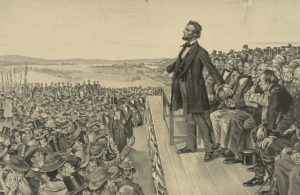 soldiers in the area, because the civilians had run far from the area.
soldiers in the area, because the civilians had run far from the area.
Even the non-war events of history had to have a “survivor” to tell about the event. It may not have been a violent event, but the Gettysburg Address would never have been known to anyone, if it had been spoken aloud in President Lincoln’s study with no one present. The speech might have been found later, but the depth of it’s meaning might have been completely lost had one witness not been so deeply moved by the speech. I wonder how much history was lost because no one was there to see and then survive to tell about it. It’s something to think about.
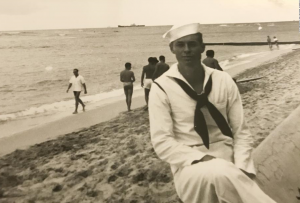 When someone is killed in a war, we are always in the hope that they will be found quickly, and identified by their friends, so that their remains can be returned to their family for a proper burial. Unfortunately, that is not always the case. Nevertheless, we hope that the time passing between death and identification is a very short amount. Unfortunately that was not the case with Carl David Dorr, who was one of the 429 sailors and Marines killed on board the USS Oklahoma when it was sunk in the Japanese attack on Pearl Harbor. Only 35 people on the ship were positively identified and buried in the years immediately following the December 7, 1941, military strike, according to the Defense Department. The unidentified remains were buried as unknowns at the National Memorial Cemetery of the Pacific, which fills the Punchbowl crater in Honolulu. For 77 years, Dorr’s family has been waiting and wondering what became of him. They knew he was at Pearl Harbor, and that he
When someone is killed in a war, we are always in the hope that they will be found quickly, and identified by their friends, so that their remains can be returned to their family for a proper burial. Unfortunately, that is not always the case. Nevertheless, we hope that the time passing between death and identification is a very short amount. Unfortunately that was not the case with Carl David Dorr, who was one of the 429 sailors and Marines killed on board the USS Oklahoma when it was sunk in the Japanese attack on Pearl Harbor. Only 35 people on the ship were positively identified and buried in the years immediately following the December 7, 1941, military strike, according to the Defense Department. The unidentified remains were buried as unknowns at the National Memorial Cemetery of the Pacific, which fills the Punchbowl crater in Honolulu. For 77 years, Dorr’s family has been waiting and wondering what became of him. They knew he was at Pearl Harbor, and that he  was on the USS Oklahoma. The bodies were there, but they could not be identified. I can’t think of anything that would be more frustrating than that. Sadly, the wait was beyond long…it was 77 years. When I think about his family, first losing their 27 year old son, and then not being able to bury their son. They died without that closure.
was on the USS Oklahoma. The bodies were there, but they could not be identified. I can’t think of anything that would be more frustrating than that. Sadly, the wait was beyond long…it was 77 years. When I think about his family, first losing their 27 year old son, and then not being able to bury their son. They died without that closure.
Carl’s family, like most American families, gathered around the radio on December 7, 1941. The news was grim. They didn’t know much yet, but they knew Carl’s ship had been attacked. With sinking hearts, they tied to hold out hope that by some miracle, he had survived. Then, they received the crushing news that he was missing in action…then, presumed dead. After the Defense Department began DNA collection in 2009, his family provided samples in hopes that one day it would help identify Carl’s body, his nephew said. His mother kept an heirloom photograph in her living room “so she could keep an eye on him,” Thomas Dorr said. She was  able to see her son every day, even if he never made it home at all. And, of course, he never did, at least during their lifetime.
able to see her son every day, even if he never made it home at all. And, of course, he never did, at least during their lifetime.
Recently, the DNA provided for identification purposed, finally paid off. Dorr’s body was finally identified, and he was going home at last. About 15 of Dorr’s relatives walked onto the tarmac of South Carolina’s Greenville-Spartanburg International Airport. As they watched, a flag-draped coffin was lowered from the plane into a hearse. “There was nothing but dead silence,” Carl’s 70-year-old nephew, Thomas Dorr, who lives in St. Johns, Florida, told CNN. “I knew that what I was experiencing was history.” Carl David Dorr was finally going to be laid to rest, and how fitting that his funeral would be held on the same day that he died, December 7, but 77 years after the day he died…Pearl Harbor Day.

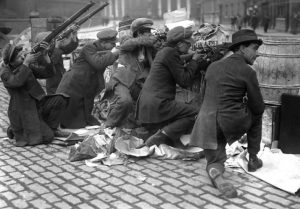 Because my family has some history in England and Ireland, the history of that area holds an interest for me. Through my DNA, I have found out that much of the family I previously thought of as English, actually originated in France. Nevertheless, they spent the majority of the centuries in England and Ireland. That said, the feuds between the two nations have been as interesting to me as the Revolutionary War. I suppose that when a nation turns an area into a territory, and then that area decides to become it’s own nation, there can be a bit of an uproar…to put it mildly. The parent nation is usually very much against the independence of the child nation…for lack of a better word.
Because my family has some history in England and Ireland, the history of that area holds an interest for me. Through my DNA, I have found out that much of the family I previously thought of as English, actually originated in France. Nevertheless, they spent the majority of the centuries in England and Ireland. That said, the feuds between the two nations have been as interesting to me as the Revolutionary War. I suppose that when a nation turns an area into a territory, and then that area decides to become it’s own nation, there can be a bit of an uproar…to put it mildly. The parent nation is usually very much against the independence of the child nation…for lack of a better word.
It was on April 24, 1916…Easter Monday, that the Irish Republican Brotherhood, which was a secret organization of Irish nationalists led by Patrick Pearse, launched the so-called Easter Rebellion in Dublin. It was an armed uprising against British rule. The Brotherhood was assisted by militant Irish socialists under James Connolly. Pearse and his fellow Republicans rioted and attacked British provincial government headquarters across Dublin and seized the Irish capital’s General Post Office. After their quick initial success, they proclaimed the independence of Ireland, and by morning they controlled much of the city of Dublin. They were fighting against the repressive government of the United Kingdom that they had been under for centuries. Their hopes of freedom were dashed later the next day when the British authorities launched a counterattack. By April 29th, it was all over. The uprising had been crushed. Nevertheless, the Easter Rebellion is considered a significant marker on the road to establishing an independent Irish republic.
Following the uprising, Pearse and 14 other nationalist leaders were executed for their participation, but they were held up as martyrs by many in Ireland. There was a lot of anger among most Irish people for the British, who had enacted a series of harsh anti-Catholic restrictions, the Penal Laws, in the 18th century, and then let 1.5 million Irish starve during the Potato Famine of 1845-1848. Armed protest continued after the Easter Rebellion and in 1921, 26 of Ireland’s 32 counties won independence with the declaration of the Irish Free State. The Free State became an independent republic in 1949. However, six northeastern counties of the Emerald Isle remained part of the United Kingdom. This prompted some nationalists to reorganize themselves into the Irish Republican Army (IRA) to continue their struggle for full Irish independence.
In the late 1960s, spurred on in part by the United States civil rights movement, Catholics in Northern Ireland, who had long been discriminated against by British policies that favored Irish Protestants, advocated for justice. Riots broke out between Catholics and Protestants in the region and the violence escalated as the pro-Catholic IRA battled British troops. Most people have heard about this struggle over the years. An ongoing series of terrorist bombings and attacks ensued in a drawn-out conflict that came to be known as “The Troubles.” Peace talks 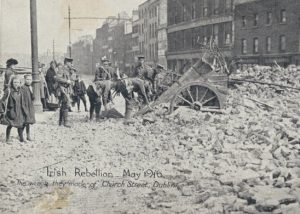
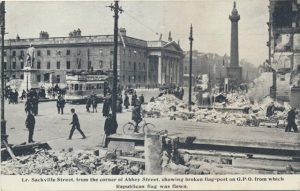 eventually took place throughout the mid to late 1990s, but a permanent end to the violence remained elusive, until July 2005, when IRA finally announced that its members would give up all their weapons and would pursue the group’s objectives solely through peaceful means. By the fall of 2006, the Independent Monitoring Commission reported that the IRA’s military campaign to end British rule was over.
eventually took place throughout the mid to late 1990s, but a permanent end to the violence remained elusive, until July 2005, when IRA finally announced that its members would give up all their weapons and would pursue the group’s objectives solely through peaceful means. By the fall of 2006, the Independent Monitoring Commission reported that the IRA’s military campaign to end British rule was over.
 I am a bit of a forensics buff. Not that I perform the tests that forensic scientists do, I just like watching shows that tell about those tests, and then I try to guess who did the crime. I don’t suppose that I would be the kind of person an innocent man would want to be performing the tests that were going to keep him out…or land him in prison. For an innocent man or woman, being accused of that crime is the beginning of a nightmare. No one wants to believe him, because everybody claims to be innocent…right? Unfortunately, many people accused of crimes are innocent, and in days gone by…before things like DNA matching and fingerprints, the only evidence available was eye witnesses and circumstantial evidence, both of which were far from infallible. Eye witnesses are notoriously unreliable, and it isn’t really their fault, because they were, after all, shook up!!
I am a bit of a forensics buff. Not that I perform the tests that forensic scientists do, I just like watching shows that tell about those tests, and then I try to guess who did the crime. I don’t suppose that I would be the kind of person an innocent man would want to be performing the tests that were going to keep him out…or land him in prison. For an innocent man or woman, being accused of that crime is the beginning of a nightmare. No one wants to believe him, because everybody claims to be innocent…right? Unfortunately, many people accused of crimes are innocent, and in days gone by…before things like DNA matching and fingerprints, the only evidence available was eye witnesses and circumstantial evidence, both of which were far from infallible. Eye witnesses are notoriously unreliable, and it isn’t really their fault, because they were, after all, shook up!!
After spending years in prison, at least fifty people have been exonerated since the dawning of DNA testing. it’s probably hard to say how many have been proven innocent based of fingerprint evidence. And I have to wonder how many have died innocently in prison because they were convicted long before the tests that might have set them free. Fingerprint identification has been used for over a hundred years now, and at one time was considered the best way to prove innocence or guilt. Of course, they aren’t infallible in that respect, because while no two fingerprints have been found to be alike in all those years, it is entirely possible for someone to be somewhere, but not at the time of a crime. If all you have to go on is fingerprints, that can be incriminating…even for an innocent person. Unfortunately, it was not foolproof.
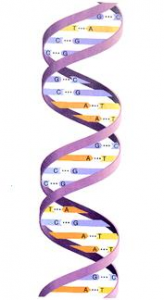
In April of 1953, Watson and Crick published a model of the DNA helix in a one page letter to ‘Nature’. It began with the now famous under statement: “We wish to suggest a structure for the salt of Deoxyribose Nucleic Acid (D.N.A.). This structure has novel features which are of considerable biological interest.” It would take until 1984 before Alec Jefferies and his colleagues would develop genetic fingerprinting, which is using DNA to identify individuals. Finally in 1987 in the United Kingdom, forensic investigators used DNA testing to help solve the ‘Black Pad’ murders and to identify the killer as Colin Pitchfork, who later confessed to the crimes. This was the first case in which DNA evidence is used to determine the identity of a murderer and it also involved a mass screen. It also marks the first case in which a prime suspect was exonerated due to DNA evidence. In 1994 DNA evidence was used in Ireland, and by the 1995 trial of OJ Simpson, it was finally used in America. It seems very strange to me to think that DNA evidence has only been used in the United States for twenty years. To me, it seems like it has been around for a really long time, but that really isn’t so. Nevertheless, on June 28, 1993 DNA evidence cleared Kirk Bloodsworth, an ex-Marine, of a murder for which he had been convicted on this day, July 24, 1984. Sadly, he served nine years before his case was reviewed and he was finally set free.
 Recently, I received an email on my Ancestry account. It was from a woman named Laura Weber. Through her husband’s DNA, she was able to connect him to the Spencer side of our family, and this brings the family connections to another fork in the road. It seems that Laura’s husband, Nicholas is a descendent of Clifford Spencer, who is the son of William Spencer and Viola Fuller, and is my grandfather, Allen Luther Spencer’s younger brother. Clifford first married a woman named Annie, and they had a daughter named Ethyl Pearl. They were divorced, and he married a woman named Hanna, and they had three children, Loraine, Clifford, and Wanda.
Recently, I received an email on my Ancestry account. It was from a woman named Laura Weber. Through her husband’s DNA, she was able to connect him to the Spencer side of our family, and this brings the family connections to another fork in the road. It seems that Laura’s husband, Nicholas is a descendent of Clifford Spencer, who is the son of William Spencer and Viola Fuller, and is my grandfather, Allen Luther Spencer’s younger brother. Clifford first married a woman named Annie, and they had a daughter named Ethyl Pearl. They were divorced, and he married a woman named Hanna, and they had three children, Loraine, Clifford, and Wanda.
Ethyl Pearl always felt very much alone after her dad left, and while she grew up around her mother’s family, she never really got over losing her dad. She married a man named Claude Coleman, and they had six children, Joyce, Duane, Laura, Claude Jr, Alfred, and Lois. Her husband was not the staying kind either, and in the end, I think it might have been for the best, or at least as far as my Uncle Bill was concerned. For part of their your life, the Coleman children lived with my grandmother, Anna Schumacher Spencer, and the children went to school and helped out on the farm. It was a good life, but like their mother, they missed their dad…no matter what the circumstances of his departure.
Ethyl’s daughter, Lois married a man named Weber. He and Lois had three biological sons, and one adopted daughter. One son, Peter passed away in 1981, and their adopted daughter, 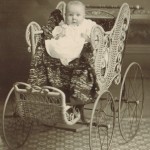 Terry passed away in 2008. The sons who are still alive are Mark and Joe. Mark married a woman named Margaret Mason. They had Nicholas (Nick), and then divorced. It is Nick’s wife, Laura, who made the connection with me, and we are both very excited about this new connection.
Terry passed away in 2008. The sons who are still alive are Mark and Joe. Mark married a woman named Margaret Mason. They had Nicholas (Nick), and then divorced. It is Nick’s wife, Laura, who made the connection with me, and we are both very excited about this new connection.
It is so amazing to me to be able to connect with yet another branch of the family. I hope to have some pictures of Lois in the future, as well as possible introduce the Weber’s to the rest of the family. I have been so excited about the family members I have found through the DNA I sent in to Ancestry. It has opened so many new doors, and there will be more in the future.
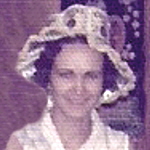 This picture of my cousin Shirley, was taken in the 70’s. The focus isn’t great, but you can easily see how pretty Shirley is. This picture has stayed in my memory files for many years. It was taken at my parents’ house in about 1979 or so. I’m not sure why this picture has stayed in my memory, but a few months ago, I saw a picture that had been in a album of my dad’s, and this picture immediately came to mind. I was amazed at how much Shirley looked like this ancestor…whoever she was. I do know that she is from my dad’s side of the family, so she is related to Shirley, as well as my sisters and me. That would explain the similarity between the two faces.
This picture of my cousin Shirley, was taken in the 70’s. The focus isn’t great, but you can easily see how pretty Shirley is. This picture has stayed in my memory files for many years. It was taken at my parents’ house in about 1979 or so. I’m not sure why this picture has stayed in my memory, but a few months ago, I saw a picture that had been in a album of my dad’s, and this picture immediately came to mind. I was amazed at how much Shirley looked like this ancestor…whoever she was. I do know that she is from my dad’s side of the family, so she is related to Shirley, as well as my sisters and me. That would explain the similarity between the two faces.
I was, nevertheless quite surprised at the similarity between these two relatives. I guess we usually are when someone looks so much like someone else, and that someone could be 100 years older or more. It’s like time doesn’t mean anything, and relative closeness doesn’t mean anything. It’s all about DNA and bloodlines. That’s what makes us the people we are…or at least, the people we look like. To me, that is so amazing. How could things like DNA, which is too small to even be seen, affect the people we will become, in such a 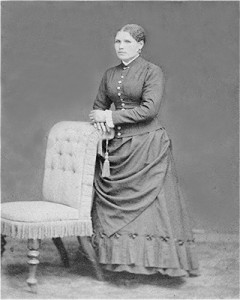 big way? Even though Scientists now know about DNA, they still don’t know exactly how it works, because there are lots of relatives in our family, and yet, not all the people in our family look alike.
big way? Even though Scientists now know about DNA, they still don’t know exactly how it works, because there are lots of relatives in our family, and yet, not all the people in our family look alike.
I guess that is something we will never fully understand in this lifetime, but we do know that DNA can be used to trace our ancestors…with complete accuracy. That is something we can’t do perfectly…even with the wide range of resources we have these days…at least not without the help of DNA. Nevertheless, we have pictures, and memories, and records that have been kept…and with those we can go quite a long way toward knowing about our ancestors. The rest will have to wait.
Today is Shirley’s birthday. I am glad that the Internet and Facebook, two other resources we have now, have reconnected our lives. You are so important us. We were out of touch for too long. DNA and bloodlines have made us family…who we are has made us friends. Happy birthday Shirley!! Have a great day!! We love you!!

